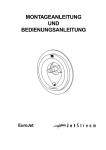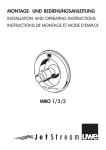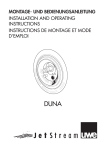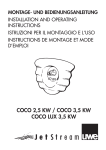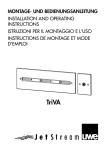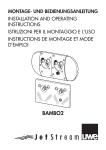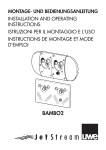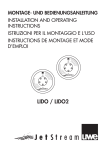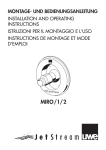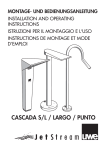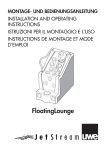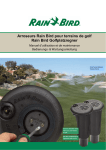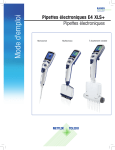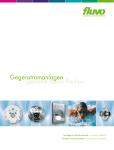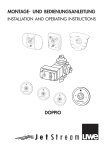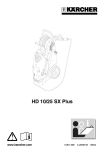Download EuroJet - JetStream UK Ltd
Transcript
Montage- und Bedienungsanleitung GB INSTALLATION AND OPERATING INSTRUCTIONS F INSTRUCTIONS DE MONTAGE ET MODE D’EMPLOI I INSTRUZIONE PER IL MONTAGGIO E L’USO EuroJet 1 D Inhaltsverzeichnis MONTAGE UND BEDIENUNGSANLEITUNG ........................................ Seite 3 - 15 GB Table of Contents INSTALLATION AND OPERATING INSTRUCTIONS .......................... page F 16-27 Contenu INSTRUCTIONS DE MONTAGE ET MODE D’EMPLOI ....................... page 2 28-39 D Vorwort Ihr Gerät ist nach dem neuesten Stand der Technik gebaut und betriebssicher. Es können jedoch von dem Gerät Gefahren ausgehen, wenn es nicht von geschulten oder eingewiesenen Personen oder zu nicht bestimmungsgemäßem Gebrauch eingesetzt wird. Deshalb muß von jeder Person, die mit der Aufstellung, Inbetriebnahme, Bedienung, Wartung und Reparatur des Gerätes beauftragt ist, die Bedienungsanleitung und besonders die Sicherheitshinweise gelesen und verstanden werden. Lassen Sie sich bzw. Ihr Personal unbedingt vor dem ersten Einsatz des Gerätes vom Fachberater unterweisen. Sollten wider Erwarten an Ihrem Gerät technische Defekte auftreten, wenden Sie sich bitte an die Kundendienststelle oder Ihren Händler. INHALTSVERZEICHNIS SEITE 1 SICHERHEITSHINWEISE .......................................................................................................................... 3-4 2 EINSETZEN DES DÜSENMANTELGEHÄUSES IN DIE SCHALUNG ...................................................... 5-7 3 FERTIGMONTAGE/ANGABEN NUR FÜR AUTORISIERTE PERSONEN ............................................... 8-10 4 4.1 4.2 4.3 4.4 4.5 4.6 4.7 4.8 INBETRIEBNAHME/ANGABEN FÜR DEN BENUTZER DER ANLAGE ............................................. 10-12 VOR DER INBETRIEBNAHME .................................................................................................................... 10 ERSTINBETRIEBNAHME DER ANLAGE .................................................................................................... 10 START ........................................................................................................................................................ 11 STRAHLSTÄRKE ........................................................................................................................................ 11 MASSAGE ............................................................................................................................................. 11-12 GEGENSTROMSCHWIMMEN.................................................................................................................... 12 ÜBERWINTERN ......................................................................................................................................... 12 WIEDERINBETRIEBNAHME ....................................................................................................................... 12 5 WARTUNG ................................................................................................................................................. 12 6 MONTAGE DER HALTEGRIFFE ............................................................................................................... 13 7 AN DEN ELEKTROINSTALLATEUR .................................................................................................... 14-15 1 SICHERHEITSHINWEISE 1.1 Vor der Inbetriebnahme Die Sicherheitshinweise und die Bedienungsanleitung müssen vor der Aufstellung und Inbetriebnahme aufmerksam gelesen und beachtet werden. Halten Sie unbedingt die Anforderungen der Firma uwe bzw. der Normgeber ein. 1.2 Erstinbetriebnahme des Gerätes Vor jeder Inbetriebnahme sind die örtlichen Sicherheitsbestimmungen sowie die Sicherheitshinweise einzuhalten. 1.3 Gefahrenquellen Warnung! Die JetStream Anlage spritzt durch die Strahldüsen bis zu 780 Liter Wasser pro Minute in das Becken ein. Wird diese enorme Kraft voll zur Massage eingesetzt, kann dies zu Verletzungen der Muskulatur, des Bindegewebes und zu inneren Verletzungen führen. Aufgrund des verringerten elektrischen Widerstandes des menschlichen Körpers in Schwimmbädern und der daraus resultierenden erhöhten Wahrscheinlichkeit des Auftretens gefährlicher Körperströme, werden erhöhte sicherheitstechnische Anforderungen an die Elektoinstallation gestellt. Deshalb halten Sie unbedingt folgende Sicherheitshinweise ein. Der Düsenstrahl besitzt eine erhebliche Energie. Drosseln Sie vor dem Massieren unbedingt den Strahldruck. Warnung Nicht den vollen Massagestrahl gegen die Weichteile des Körpers richten. Zum Schwenken der Strahldüse Pumpe abschalten. Zur großflächigen Massage Strahlstärke auf halbe Stärke drosseln. Zum Massageschlauch aufsetzen und abnehmen, Pumpe abschalten. Halten Sie zur Punktmassage die Düse des Massageschlauches unter Wasser fest in der Hand. Führen Sie die Düse des Massageschlauches mit Abstand über die gewünschten Stellen. 3 Anforderungen an die entsprechende elektrische Installation entnehmen Sie bitte dem im Heft aufgeführten Abschnitt 7 „ An den Elektroinstallateur “. Teile der Einrichtung, die unter Spannung stehende Teile enthalten, müssen für Personen, die das Bad benutzen, unzugänglich sein. Geräte und Geräteteile, welche elektrische Bauteile enthalten, müssen so aufgestellt bzw. befestigt werden, daß sie nicht ins Wasser fallen können. Geräte der Schutzklasse I müssen dauerhaft an festverlegte Leitungen angeschlossen sein. 1.4 Bestimmungsgemäße Verwendung Das Gerät ist ausschließlich bestimmt zum Betreiben in überdachten Schwimmbädern und Schwimmbädern im Freien bei einer Wassertemperatur bis zu 35° C. Das Gerät ist zur Aufstellung und Betrieb in Anlagen und Räumen in den Bereichen 1 und 2 nach DIN VDE 0100 T 702 geeignet. Die Pumpe wird normalerweise in den Beckenumgang aufgestellt, es muß jedoch gewährleistet sein, daß der Raum trocken und der Motor gegen Überflutung durch einen ausreichend dimensionierten Bodenablauf geschützt ist. Der Steuerkasten sollte entweder in einem trockenen Umgang oder in einem angrenzenden Raum, möglichst höher als der Wasserspiegel untergebracht sein. Die Anlagen dürfen nur bestimmungsgemäß verwendet werden. Jeder darüber hinausgehende Gebrauch gilt als nicht bestimmungsgemäß. Für hieraus resultierende Schäden haftet der Hersteller nicht; das Risiko hierfür trägt allein der Benutzer. Zur bestimmungsgemäßen Verwendung gehört auch die Einhaltung der vom Hersteller vorgeschriebenen Betriebs-, Wartungs- und Instandhaltungsbedingungen. Wartungs-, Reparaturarbeiten und dergleichen dürfen nur von autorisierten Personen durchgeführt werden. Das Gerät darf nur von Personen genutzt werden, die hiermit vertraut und über die Gefahren unterrichtet sind. Die einschlägigen Unfallverhütungs-Vorschriften sowie die sonstigen allgemein anerkannten sicherheitstechnischen, arbeitsmedizinischen Regeln sind einzuhalten. Eigenmächtige Veränderungen am Gerät schließen eine Haftung des Herstellers für daraus resultierende Schäden aus. 1.5 Produkthaftung Der Benutzer wird ausdrücklich darauf hingewiesen, daß das Gerät ausschließlich bestimmungsgemäß eingesetzt werden darf. Für den Fall, daß das Gerät nicht bestimmungsgemäß eingesetzt wird, geschieht dies in der alleinigen Verantwortung des Anwenders. Jegliche Haftung des Herstellers entfällt somit. 1.6 Verhalten im Notfall Wasser sofort verlassen und Geräte durch Hauptschalter oder Sicherungen spannungsfrei schalten und gegen unbefugtes Wiedereinschalten sichern. 1.7 Erklärung der Gefahrensymbole Warnung Warnung! In dieser Bedienungsanleitung haben wir alle Stellen, die Ihre Sicherheit betreffen, mit diesem Zeichen versehen. Geben Sie alle Sicherheitsanweisungen auch an andere Benutzer weiter. In dieser Bedienungsanleitung haben wir alle Stellen, die funktionsnotwendige Hinweise enthalten, mit diesem Zeichen versehen. Bitte beachten Sie unbedingt diese Hinweise, um Schäden am Gerät zu vermeiden. 4 2 EINSETZEN DES DÜSENMANTELGEHÄUSES IN DIE SCHALUNG • Montage (Bild 1) Schrauben Sie das Düsenmantelgehäuse so in die Schalung, daß das rote Schild mit Text „oben“ nach oben zeigt. Funktion Dann befindet sich, von der Beckeninnenseite her gesehen, der Druckstutzen auf der senkrechten Mittelachse über dem Gehäusemittelpunkt, der Saugstutzen rechts unten, der Luftansaugschlauch links oben. Setzen Sie das Düsenmantelgehäuse bündig mit der Beckenwand ein. Erhält das Becken für eine Folienauskleidung einen Putz- oder Dämmplattenauftrag, so müssen Sie das Düsenmantelgehäuse um die Putz- bzw. Dämmplattenstärke vorziehen. 1 Schalbrett Beton Wa ss pie (optimal 28,7) 23,7 - 38,7 ers Luftansaugschlauch 4 m 24 ge l Druckstutzen Schild “oben" Ø Spezialnippel nicht austauschen 28 ,9 SechskantSchraube M 8 x 50 aus Kunststoff 25 ,6 Ø 5 31 vor dem Fliesen Schutzkappen am Rand einschneiden und abziehen Saugstutzen Düsenmantelgehäuse • Fliesenplan (Bild 2) Fliesen Sie das Düsenmantelgehäuse bis zu seiner Innenkante. • Becken mit Folienauskleidung (Bild 3) Ordnen Sie Klemmrahmen, die Dichtungen aus Folienmaterial und die Gummidichtung nach Bild 3 an. 2 3 Klemmring Dichtung vor und hinter der Folie je eine Dichtung aus Folienmaterial Fliesen bis zur Innenkontur Putz- und Fliesenausgleich bis 5 cm Wasserspiegel Beton Folie 20-35 (opt. 25) Wasserspiegel 23,7 - 38,7 (optimal 28,7) 3,7 Ø 25 Betondichtflansch ,6 Ø 31 24 Abmessungen in cm 6 Einbau des Düsenmantelgehäuses in ein Stahl-, Alu- und Polyesterbecken Luftansaugschlauch zur Ansaugung der Luft aus dem Beckenumgang 5-10 cm über dem Wasserspiegel Wasserspiegel Wasserspiegel oben Luftschlauch 45° 36 Kabelschutzschlauch 3,7 Ø 25 ,6 Ø 23 ,5 Lage der Düse Klemmrahmen °= 0° 20-35 (opt. 25) 8x45 Dichtung Senkschraube M 8x35 Ø 0,9 Ausschnitt und Bohrungen in der Beckenwand am besten mit Hilfe des Klemmrahmens anreißen bzw. abbohren Beckenwand Düsenmantelgehäuse 24,0 Saugstutzten Ø 31 max. Betonwandstärke Abmessungen in cm Einbau des Düsenmantelgehäuses in ein Becken mit Überflutungsrinne Luftansaugschlauch zur Ansaugung der Luft aus dem Beckenumgang 5-10 cm über dem Wasserspiegel Wasserspiegel Wasserspiegel 20-35 (opt. 25) ~42 ~35 oben 23,7 - 38,7 (optimal 28,7) ~1 3, Lage der Düse 5 3,7 Ø 25 ,6 Düsenmantelgehäuse ~8 Dichtung Bohrungen im Schalbrett mit Bohrschablone bohren Saugstutzen Leerrohr für Pneumatik-Schlauch Schalbrett 24 Abmessungen in cm 7 Ø 31 3 FERTIGMONTAGE ANGABEN NUR FÜR AUTORISIERTE PERSONEN Vor der Montage Die Sicherheitshinweise müssen vor der Aufstellung aufmerksam gelesen werden. Halten Sie unbedingt die Anforderungen der Fa. uwe bzw. der Normgeber ein. Für den Fall, daß die Hinweise nicht berücksichtigt werden, geschieht dies in der alleinigen Verantwortung des Monteurs. Jegliche Haftung des Herstellers entfällt somit. Endmontage (Bild 5) Montage der Düse und des Pneumatikschlauches 1. Die Mutter der Stopfbüchse (10) entfernen. Mittelscheibe entfernen. Lassen Sie die Dichtung (13) im Gehäuse. 2. Auf eine der Seiten des Doppelanschlußstutzens (11) legen Sie den 10 m langen Steuerungsschlauch (aus PVC, 2/4 Durchmesser) und ihn von hinten durch den Schutzschlauch herauslassen. 3. Den Pneumatik Schlauch der sich auf der Drucktaste (3) befindet durch die Mutter der Stopfbüchse (10) durchziehen und auf der Innenseite des Doppelanschlußstutzen (11) befestigen. Die Mutter der Stopfbüchse festziehen. 4. Legen Sie 5 Scheiben aus weißem Kunststoff (9) auf dem Boden des Düsengehäuses (15). Legen Sie die weiße Gummidichtung (8) und die Klemmbrille (7) ein. Danach setzen sie die Düse (6) und die Klemmbrille (5) ein. Die Klemmbrille (5) wird auf der Düse mit 4 Schrauben (4) befestigt. Bitte achten Sie darauf daß die Düse manuell in die gewünschten Richtungen gelenkt werden kann. Sollte dies nicht der Fall sein müssen Sie eine der Scheiben (9) entfernen. 5. Die Frontplatte (2) mit den 2 Senkschrauben (1) leicht anziehen Montage Pumpe, Saug- und Druckschlauch bei Ausführung mit PVC-Fittings Setzen Sie die Pumpe entweder mit einem Schwingmetall (Stoßdämpfer) auf die Konsole oder, wenn Sie einen Sockel betonieren möchten, unterbauen Sie diesen entsprechend. Kleben Sie mit „TANGIT“ den Saug- und Druckschlauch in die Übergangsmuffe des Rohbauteils. Nach dem Kleben sollten sich die Kugelhähne öffnen und schliessen lassen (siehe Bild 4). Wichtig: Achten Sie darauf, daß der Saug- und Druckschlauch richtig verklebt wird (siehe Bild 4, Pfeil auf dem Kugelhahn). Funktion Vergessen Sie dabei nicht die Dichtung zwischen Schlauchnippel und Pumpenstutzen einzulegen. Warnung Schrauben Sie die Pumpe fest, bzw. setzen Sie die Steinschrauben. Wichtiger Hinweis: Die Pumpe wird normalerweise in dem Beckenumgang aufgestellt. Warnung Der Aufstellungsraum muß trocken, belüftet und durch einen ausreichend dimensionierten Bodenablauf gegen Überflutung geschützt sein. Montage Luftansaugschlauch (Bild 5) Bringen Sie auf das Ende des Luftansaugschlauches das beiliegende Rückschlagventil auf. Dübeln Sie dazu den Halter (17) so in die Wand, daß die Oberkante des Ventils (16) mindestens 5 cm über dem max. Wasserspiegel des Schwimmbeckens liegt. Schieben Sie den Schlauch über den Schlauchnippel des Ventils. Klemmen Sie den Schlauch mit der Schlauchschelle fest. Hinweis: Das Ventil (16) fängt einen eventuell vorkommenden Rückstau ab, der sich z.B. bei Verwendung des Warnung Massageschlauches, der Düse für Rückenmassage oder bei mutwilligen Verschließen der Düse bilden kann. Das Ventil verhindert, daß Wasser aus dem Luftansaugschlauch spritzt. Das Ventil ist nur dicht, solange sich keine Ablagerungen oder Haare darin festsetzen. Deshalb das Ventil unbedingt über dem Wasserspiegel anbringen. Kürzen Sie den Luftansaugschlauch, wenn dieser länger ist, als Sie ihn benötigen. Je kürzer der Luftansaugschlauch, desto geringer ist sein Widerstand und umso höher ist der Luftdurchsatz. 8 4 5 Steuerkasten oberhalb des Wasserspiegels montieren 16 17 18 19 9 8 7 6 5 4 15 14 11 12 13 10 1 2 3 Anschluss Steuerkasten (Bild 5) Der Steuerkasten (18) sollte entweder in einem trockenen Umgang oder in einem angrenzenden Raum untergebracht werden. Der Anschluss ist sorgfältig nach DIN VDE 0100 Teil 702 auszuführen. Der Anschluss an das Netz erfolgt durch eine 5 G 2,5 mm² (3N ~ PE 400V) oder durch 4 G 2,5 mm² (3 ~ PE 230V) Leitung. In diese Zuleitung ist sowohl ein Hauptschalter, mit dem das Gerät allpolig vom Netz getrennt werden kann, als auch in FI-Schalter vorzusehen. (siehe Hinweisblatt: „An den Elektroinstallateur“) Stecken Sie den 10 m langen PVC-Schlauch, der vom Düsenmantelgehäuse kommt, auf den Nippel des PE-Wandlers (19) außerhalb des Steuerkastens (18). 9 ca.. 5-10 cm über dem Wasserspiegel JetStream EuroJet Einbau in Betonbecken ohne Überflutungsrinne 58 18 22 6 15,6 20 - 35 (optimal 25) 50 Ø 82 25,5 34 43 ,0 24 Abmessungen in cm 4 INBETRIEBNAHME BEDIENUNG/ANGABEN FÜR DEN BENUTZER DER ANLAGE 4.1 Vor der Inbetriebnahme Die Sicherheitshinweise und Bedienungsanleitung müssen vor dem Aufstellen und der Inbetriebnahme aufmerksam gelesen werden. 4.2 Erstinbetriebnahme der Anlage Vor jeder Inbetriebnahme sind die örtlichen Sicherheitsbestimmungen sowie die Sicherheitshinweise einzuhalten. Ist das Gerät komplett montiert und elektrisch angeschlossen, kann das Gerät in Betrieb genommen werden. Bevor Sie die uwe JetStream Anlage in Betrieb nehmen, drehen Sie den Motor am Lüfterrad von Hand mehrmals durch. Warnung Hinweise an den Betreiber: Keine mangelhafte Anlage in Betrieb nehmen. Sicherheitshinweise deutlich sichtbar anbringen. Gebrauchsanweisung bereithalten. Wassertemperatur bis max. 35° C. 10 4.3 Start Zum Schwenken der Strahldüse Pumpe abschalten. Warnung Wenn Sie den Pneumatik-Schalter (1) drücken, wird die Anlage EIN bzw. AUS geschaltet. Bei Verwendung eines wassergeschützten Lichttasters, der bauseits zu stellen ist, können Sie das Pumpenaggregat auch von einem anderen Ort aus schalten. Die Düse ist in jede Richtung mit einem Winkel von 30° einstellbar. Bei Einstellung der Düse muss die Pumpe unbedingt ausgeschaltet sein. 4.4 Strahlstärke Achtung: Der Düsenstrahl hat eine erhebliche Energie. Strahlstärke unbedingt regeln! Warnung Wenn Sie den vorderen Düsenkopf (2) drehen, können Sie die Strahlstärke bis auf ein Drittel der Maximalstärke reduzieren. Strahldüse (3) Strahlstärke-Regler (2) Pneumatik-Schalter (1) 4.5 Massage Drosseln Sie vor dem Massieren unbedingt den Strahldruck. Nicht den vollen Massagestrahl gegen die Weichteile des Körpers richten. Warnung Zur großflächigen Massage Strahlstärke auf halbe Stärke drosseln. Zum Aufsetzen und Abnehmen des Massageschlauches Pumpe abschalten. Halten Sie zur Punktmassage die Düse des Massageschlauches unter Wasser fest in der Hand. Führen Sie die Düse des Massageschlauches mit Abstand über die gewünschte Stelle. • Massageschlauch Wenn Sie den Massageschlauch aufsetzen oder abnehmen möchten, schalten Sie vorher die JetStream Anlage aus. Warnung Stecken Sie den Massageschlauch auf die Strahldüse (3) und verriegeln Sie diesen mit Hilfe des verschiebbaren Rings. Zum Abnehmen des Massageschlauches halten Sie den Schlauch mit einer Hand fest und mit der anderen Hand entriegeln Sie den verschiebbaren Ring in Richtung Schlauch. Jetzt können Sie den Schlauch von der Strahldüse abziehen. • Punktmassage Für die gezielte Massage von bestimmten Körper- und Muskelpartien verwenden Sie den Massageschlauch mit der kleinen Düse. Dabei halten Sie die Schlauchdüse unter Wasser fest in der Hand und führen die Düse mit Abstand zur gewünschten Stelle. Je kürzer der Abstand zwischen Düse und Körper ist, desto kräftiger der Massagedruck. 11 • Rückenmassage Zur Rückenmassage benutzen Sie die spezielle Düse in Option, wie der Massageschlauch ist sie auf der einstellbaren Düse angebracht. Stellen Sie sich mit dem Rücken vor die Düse, und halten Sie sich während der Massage fest. Je kürzer der Abstand zwischen Strahl und Körper ist, desto stärker ist der Strahl. Achtung: Die Kraft des Wasserstrahls ist gewaltig. Es wird empfohlen den Wasserstrahl nicht gegen die Weichteile des Körpers zu richten: Warnung • Großflächige Massage Stellen Sie sich einfach direkt vor die Strahldüse, nachdem Sie den Strahl auf halbe Stärke gedrosselt haben. Durch den breiten Druckstrahl werden die Haut, das Gewebe darunter und die Muskulatur kräftig durchmassiert. Das fördert die Durchblutung, lockert und entspannt. 4.6 Gegenstromschwimmen Stellen Sie die JetStream auf volle Strahlstärke ein. Die Lage der einstellbaren Düse muss so sein, dass eine starke Strömung direkt unterhalb des Wasserpegels erzeugt wird, ohne grosse Oberflächenwirbel zu verursachen. 4.7 Überwintern Wenn die JetStream EuroJet frostgefährdet ist, wird empfohlen den Wasserpegel des Schwimmbeckens unterhalb der Ansaugung zu bringen. Entfernen Sie die Wasserablaufmutter am unteren Teil der Pumpe. Nach dem Wasserablauf die Mutter nicht wieder montieren Warnung 4.8 Wiederinbetriebnahme Mutter am unteren Teil der Pumpe wieder zuschrauben. Um die Pumpe eventuell freizumachen, bringen Sie diese manuell in Bewegung. (Bringen Sie die Flügel des Ventilators mit Hilfe eines Schraubendrehers in Bewegung.) Danach schalten Sie die Pumpe an. 5 WARTUNG Gerät vom Netz trennen! Das Gerät immer nur in einwandfreiem Zustand betreiben. Auf regelmäßige Wartung und ÜberWarnung prüfung der technischen Einrichtungen achten. Bei Reparatur- bzw. Wiederinbetriebnahmetätigkeiten sind zusätzliche Maßnahmen, wie Abschrankung gegen den Zutritt Unbefugter unbedingt notwendig. Es dürfen nur autorisierte Personen an dem Gerät arbeiten. Es ist jede Arbeitsweise zu unterlassen, die die Sicherheit an dem Gerät beeinträchtigt. Beziehen Sie immer nur Original-Ersatzteile über Ihren Händler oder die Fa. uwe. 12 6 MONTAGE DER HALTEGRIFFE Montage in Betonbecken mit Putz oder Fliesenauskleidung Montage 1 Obere Halteseildeckel wie vermaßt verschrauben. 2 Untere Haltseildeckel leicht nach unten ziehen, so daß sich das Halteseil gerade richtet. 3 Schraubenlöcher abbohren und Deckel verschrauben. Halteseildeckel 45 50 Ø8 Düse 105 58 Halteseildeckel gestrichelte Schrauben werden nur für Fertigbecken benötigt Dichtung JETSTREAM ca. 736 Dübel Senkholzschraube 800 Die Haltegriffe sind symmetrisch, sie können untereinander vertauscht werden. 45 Maße in mm Montage in Stahl- Alu- oder Polyesterbecken mit und ohne Hintermauerung bzw. Hinterbeton. Dichtung Spannplatte 36 58 Ø7 Beckenwand Dichtung Senkschraube M6 x 40 Senkschraube M6 x 25 Befestigungsplatte 13 Bei Fertigbecken müssen die beiden zusätzlichen Bohrungen angezeichnet werden 7 AN DEN ELEKTROINSTALLATEUR 7.1 HINWEISE ZUM ANSCHLUSS DER STATIONÄREN SCHWIMMBECKENPUMPE JetStream EuroJet, BAMBO2, BAMBO, COCO (UNBELEUCHTETE AUSFÜHRUNGEN) VIVA, LIBRA 3-5, LIDO, LIDO2 FÜR DREHSTROM 3N PE ~ 400 V 230 V 50 HZ UND 1 N PE ~ 230 V - 50 HZ Es geht um Ihre Sicherheit! Führen Sie deshalb die Anschlussarbeiten sorgsam nach den Bestimmungen DIN VDE 0100 Warnung Teil 702 aus. Halten Sie unbedingt die Sicherheitshinweise und die Anforderungen der Normgeber ein. Alle Arbeiten an den stationären Schwimmbeckenpumpen dürfen nur durch von der Fa uwe autorisierten Firmen oder durch geschulte Elektrofachkräfte durchgeführt werden. Die DIN VDE und zutreffenden Unfallverhütungsvorschriften sind bei Arbeiten mit Spannung zu beachten. Wichtige Hinweise Warnung 1 Anschluss an die Hausinstallation Für den Netzanschluss zum Steuerkasten und Motor sind bei 400 V 3N AC 50 Hz (Drehstrom) ein Leitungsquerschnitt von mindestens 5 G 2,5 qmm Cu erforderlich (Leitungslänge beachten). In die Netzzuleitung muss ein allpoliger Trennschalter vorgesehen werden. 2 Schutzmassnahmen Das Aggregat ist gegen zu hohe Berührungsspannung durch Schutzerdung DIN VDE 0100 Teil 702, sowie durch Vorschaltung eines Fehlerstrom-Schutzschalters FI ≤ 30 mA zu sichern. Ausserdem ist der Motor nach DIN VDE 0100 Teil 702 an den Potentialausgleich anzuschliessen. 3 Absicherung Bei 400 V: Schmelzsicherungen 16 A (träge) oder 16 A K- Sicherungsautomaten. Leitungslänge bzw. Spannungsabfall beachten. Bei 230 V: Schmelzsicherungen 16 A (träge) oder 16 A K- Sicherungsautomaten. Leitungslänge bzw. Spannungsabfall beachten. 4 Leistungsaufnahme Die Leistungsaufnahme des Pumpenaggregats beträgt maximal bei einer Nennspannung von 400 V 3N AC 50 Hz bei einer Anlage 5 COCO 2,5 kW bzw. 3,5 kW BAMBO2, BAMBO, VIVA, LIBRA 3-5, LIDO, LIDO2 3,5 kW EuroJet 1,7 kW bzw. 3,2 kW (1N PE ~ 230 V 50 Hz) Motorschutz Im Steuerkasten sind die erforderlichen Schalt- und Sicherheitselemente untergebracht, so dass sich ein weiterer Motorschutz erübrigt. Kontrollieren Sie bitte, ob das Überstromrelais auf den entsprechenden Motor-Nennstrom eingestellt ist. 6 Drehrichtung Prüfen Sie die Drehrichtung. Beachten Sie hierzu den Drehrichtungspfeil an der Pumpe. Zur Drehrichtungsprüfung im Trockenlauf Pumpe nur kurz einschalten, um die Gleitringdichtung vor Schaden zu bewahren. Bei falscher Drehrichtung ist die Strömungsgeschwindigkeit wesentlich geringer, ausserdem nimmt der Antriebsmotor einen höheren Strom auf, so dass das Überstromrelais ansprechen kann. Ist die Drehrichtung falsch, sind zwei Aussenleiter der Netzzuleitung durch einen Elektrofachmann zu tauschen. Montage des Steuerkastens Steuerkasten in einem trockenen Raum möglichst an einer Innenwand, oberhalb des Wasserspiegels anbringen. Führen Sie die Leitungen durch die Stopfbuchse in den Steuerkasten. Ziehen Sie die Stopfbuchse gut an, und füllen Sie den verbleibenden Raum zwischen Stopfbuchse und Leitung mit einem dauerelastischen Kitt. 14 4 3 3 6 5 5 Die bauseitige Installation ist gemäss den gültigen Bestimmungen, wie z.B. DIN VDE, TAB, VBG, UVV, auszuführen 15 K2 3.4 18 A1 A2 N PE PE L1 L2 L3 N PE 4x2,5mmý L1 N PE 30mA F2 1 F1 16A 2 1 3 4 3 6 5 13 4 3 2 1 S1 K1 RD 1 3 A1 A2 2 .5 2 .5 1 3 5 13 BN K2 1 2 A1 A2 2 .3 4 .3 6 .3 14 .4 BU 4x2,5mmý N N Die bauseitige Installation ist gemäss den gültigen Bestimmungen, wie z.B.DIN VDE, TAB, VBG, UVV, auszuführen 5 4 3 1 F4 4A 2 1 F3 2 1 S1 Hauptschalter 2 (allpol. Trennstelle) K1 Pneumatiktaster K2 RD 14 PE 2 6 1 4 M ~ 2 M1 1 1 PE PE Stromzuleitung L1 N PE Unterbrechen Sie die Stromzufuhr bevor Sie den Steuerkasten öffnen Stromstoßrelais 1 F1 16A 2 1 7 1 S2 Pneumatik- 3 schalter K1 L1 L2 L3 N PE 2 4 6 14 A2 Überstromrelais L1 L2 L3 N PE F2 30mA 8 13 6 5 5 14 6 6 5 4 3 3 6 A1 B1 A2 18 3.5 2 3.2 4 3.3 6 3.3 14 3.3 PE 4 6 4 4 3 K2 2-60 min 15 1 3 5 13 Die bauseitige Installation ist gemäss den gültigen Bestimmungen, wie z.B. DIN VDE, TAB, VBG, UVV, auszuführen N N Luftschütz 2 2 1 S1 Hauptschalter 2 (allpol. Trennstelle) 1 4 5 2 1 3 3 6 5 2 2 M 3~ 1 4 3 7 BU PE 4x2,5mmý Überstromrelais N F3 K1 3.5 M1 PE 1 F1 16A 2 1 6 5 1 2 A1 A2 2 2.3 4 2.4 6 2.4 14 2.4 1 3 5 13 A1 Erdleiter L1 L2 L3 N PE F2 30mA 4 3 5 8 6 6 3 4 4 1 F4 4A 2 2 1 3 BN K1 2 2.5 1 2 .5 3 5 13 A2 A1 1 K2 4 PE 3 2 1 2 M 3~ RD 5 13 1 6 14 K2 S1 3 Pneumatiktaster RD 2 1 Hauptschalter S1 2 (allpol. Trennstelle) F3 K1 M1 1 1 15 5 3 1 N bauseits Steuerkasten Pumpenaggregat L1 L2 L3 N PE bauseits Steuerkasten Pumpenaggregat bauseits Steuerkasten Pumpenaggregat Schaltplan für JetStream EuroJet, BAMBO2, BAMBO, COCO (unbeleuchtete Ausführung) LIBRA 3-5, LIDO, LIDO2, VIVA mit Pneumatikschalter und Zeitrelais 3 N ~ PE 50 Hz 400/230 V 16 A Schaltplan für JetStream EuroJet, BAMBO2, BAMBO, COCO (unbeleuchtete Ausführung) LIBRA 3-5, LIDO, LIDO2, VIVA mit Pneumatikschalter 3 N ~ PE 50 Hz 400/230 V 16 A Schaltplan für JetStream EuroJet, BAMBO2, BAMBO, COCO (unbeleuchtete Ausführung) LIBRA 3-5, LIDO, LIDO2, VIVA mit Pneumatikschalter und Münzzeitschalter 1 N ~ PE 230 V Elektro Kabel 380 V 3N~PE GB Preface Your unit has been built in accordance with the latest state of the art, and is safe. However, the unit can be dangerous if it is operated by persons who have not received the necessary training or instruction, or if it is used improperly. Therefore, everyone entrusted with the task of installing the unit, setting it into operation, operating, maintaining and repairing it, must read and understand the Operating Instructions and - especially - the Safety Instructions. Before using the unit for the first time, you and/or your personnel should definitely receive instructions from the specialist consultant. If, contrary to expectations, technical defects occur in your unit, please contact the customer service department or your dealer. LIST OF CONTENTS PAGE 1 SAFETY INSTRUCTIONS ...................................................................................................................... 16-17 2 INSTALLING THE WALL NICHE IN CONCRETE SHUTTERED POOLS .............................................. 18-19 3 FINAL ASSEMBLY INSTRUCIONS ........................................................................................................ 20-21 4 OPERATION / INFORMATION FOR THE USER OF THE UNIT ............................................................. 23-27 4.1 BEFORE STARTING ............................................................................................................................ 22 4.2 FIRST TIME OPERATION .................................................................................................................... 22 4.3 STARTING THE UNIT .......................................................................................................................... 23 4.4 STRENGTH OF THE JET .................................................................................................................... 23 4.5 MASSAGE ....................................................................................................................................... 23-24 4.6 SWIMMING AGAINST THE CURRENT ................................................................................................ 24 4.8 WINTERIZATION ................................................................................................................................. 24 4.8 AGAIN OPERATION ............................................................................................................................ 24 5 6 SERVICE ...................................................................................................................................................... 24 FITTING INSTRUCTION FOR HANDGRIPS ............................................................................................... 25 7 INFORMATION FOR THE ELECTRICIAN .............................................................................................. 26 -27 1 SAFETY INSTRUCTIONS 1.1 Before Setting into Operation Before installation and setting into operation, the Safety Instructions and the Operating Instructions must be carefully read and observed. You must definitely comply with the requirements of the uwe company and of the standards authorities. 1.2 Setting the Unit into Operation for the First Time Before the unit is set into operation, the local safety regulations and the Safety Instructions must always be complied with. 1.3 Sources of Danger Warning! The JETSTREAM system forces up to 700 litres of water per minute into the pool through the nozzle. If all of this enormous force is used for massage, it can cause injuries to muscles and to connective tissue, as well as internal injuries. Because of the reduced electrical resistance of the human body in swimming pools and the resulting increased probability of the occurrence of dangerous currents in the body, increased safety requirements are imposed on the electrical installation. 16 Therefore, you must definitely observe the following Safety Instructions: Warning The JETSTREAM has substantial power. Before massage, you must definitely reduce the pressure. Do not utilize full thrust against soft parts of the body. Switch off pump before adjusting angle of nozzle. For large-area massage, reduce the strength to half thrust. In order to attach and detach the massage fitting switch off the pump. To massage a single part of the body, grip the massage hose firmly. When using the hose keep a distance to those parts of the body that require massaging. Do not approch the suction filter with long hair unless tied back. Before putting the massage hose on or taking it off, switch off the pump. For point massage, hold the nozzle of the massage hose firmly in your hand under water. Guide the nozzle of the massage hose over the required places but at some distance from them. Do not dive to the intake screen (if there is one) with long, unrestrained hair. For requirements regarding the appropriate electrical installation, please see „Information for the Electrician“, as per part 7. Parts of the equipment that contain electrically live parts must be inaccessible to persons using the pool. Units and unit parts containing electrical components must be installed or fixed in such a way that they cannot fall into the water. Units of enclosure class I must be permanently connected to permanently laid cables. 1.4 Proper Operation All units are intended soleley for operation in covered swimming pools and in open-air swimming pools with a water temperature up to 35°C. The units are suitable for installing and operating in installations and rooms in areas 1 and 2 as per EN-60335-2-41. The pump is normally installed in the walkway behind the pool wall, but it must be ensured that the environment is dry and that the motor is protected by a suitably sized floor drain to prevent flooding. The control panel should be installed either in a dry walkway or in an adjacent room, if possible higher than the water level. Any kind of use other than the intended use is improper. The manufacturer will not accept liability for any damage or injury resulting from improper operation; the user alone must bear this risk. Proper operation also includes compliance with the operating, maintenance and repair conditions specified by the manufacturer. Maintenance work, repair work and suchlike may only be performed by authorised persons. The units may only be used by persons who are familiar with them and who have been informed about the dangers. The relevant regulations for the prevention of accidents and the other generally recognised rules relating to safety and to occupational medicine must be complied with. If unauthorised modifications are made on the units, the manufacturer will not accept liability for any resulting damage or injury. 1.5 Product Liability The user’s attention is expressly drawn to the fact that the unit may only be operated in the proper manner. If it is operated in an improper manner, the user must bear sole responsibility. In such cases, therefore, the manufacturer cannot accept any liability. 1.6 Procedure in an Emergency Leave the water immediately, switch off the electrical supply to the unit by operating the main power switch or circuit-breaker, and secure the unit to prevent it from being switched on again without authorisation. 1.7 Explanation of the Danger Symbols Warning! In these Operating Instructions, we have used this symbol to mark all texts which relate to Warning your safety. Please pass all safety instructions on to other users too. In these Operating Instructions, we have used this symbol to mark all texts containing instructions that are necessary for functional reasons. Please be sure to obey these instructions in order to avoid damage to the unit. Function 17 2 INSTALLING THE WALL NICHE IN CONCRETE SHUTTERED POOLS Installation (fig. 1) Position the wall niche ensuring that the read label “Oben” (top) is on top. Function Viewed from inside the pool, the suction duct is on the vertical middle axis above the center of the housing, the pressure duct at the bottom on the right side. The front of the wall niche must be set flush with the face of the wall concrete. In case of a liner/concrete pool, the wall niche may project in order to compensate for the cement render of liner insulation thickness. It is advisable to make provision for protecting tube by placing in protective conduit or through adjacent cable/ ventilation ducts. • Tile plan (fig. 2) Render and tile to inner edge of wall niche. • Pools with plastic liner (fig.3) Proceed as shown in fig. 3 1 2 shutterung r le vel 24 (optimal 28,7) 23,7 - 38,7 air inlet tube 4 m long concrete wa te presure duct label “top” Ø special nipple do not remove 28 suction duct wall niche ,9 shuttering screw M8 x 50 plasitic 25 Ø ,6 render and tile to inner edge 31 max thickness render and tile 5 cm cut into edge of yellow protective cover and remove before rendering 3 water level clamping frame water level 20-35 (opt. 25) gasket 23,7 - 38,7 (optimal 28,7) one rubber gasket to front and back of liner 3,7 Ø 25 metal frame 24 concrete ,6 liner Ø 31 18 Installing the wall niche in steel, aluminium and polyester pools air inlet tube for air suction end part to be installed 5 - 10 cm above water level water level water level air inlet label top °= 45° Ø 25 3,7 protective sleeve for pneumatic tube ,6 Ø 23 ,5 nozzle center line clamping frame 36 0° 20-35 (opt. 25) 8x45 gasket sunk screw M 8 x 35 Ø 0,9 use clamping frame for cutting and drilling pool wall wall niche suction duct Ø 31 24,0 concrete max. dimensions in cm Installing the wall niche in deck level pools with overflow channel air inlet tube for air suction end part to be installed 5 - 10 cm above water level water level water level 20-35 (opt. 25) ~42 label „top“ ~35 23,7 - 38,7 (optimal 28,7) ~1 3, nozzle center line 5 3,7 Ø 25 ,6 wall niche ~8 gasket use drilling template for drills in the shuttering suction duct protective sleeve for pneumatic tube shuttering 24 dimensions in cm 19 Ø 31 3 FINAL ASSEMBLY INSTRUCIONS INSTRUCIONS FOR AUTHORIZED PERSONS ONLY Before installation The safety instructions must be read carefully before installation. You must definitely fulfil the requirements stated by the uwe company and by the standars authorities. If the instructions are not observed, the installation engineer shall bear the sole responsibility. The manufacturer shall thus be absolved of any liability. Installing the nozzle assembly (fig.1) 1. Unscrew gland nut (10) and remove blank plastic washer. Leave rubber sealing washer (13) in housing. 2. Thread free end of the 10 m length of PVC pneumatic tube (12) through the gland aperture from within the pool. 3. On the pneumatic switch assembly (3) is a short length of pneumatic tube (12). Thread this through the gland nut (10) and fix it to end of the tube connector (11) showing inside the pool. Tighten gland nut (10). 4. Insert 5 disks from white plastic disk (9) on the ground of the jet-casing (15). After that insert seal (8) and one of the clamping disk (7) inside. Then put down the nozzle (6) and the clamping disk (5). The clamping disk (5) is fortified on the nozzle with 4 screws (4). If the nozzle wouldn’t be steered into several directions you have to put out 1 of the plastic disk (9) 5. The face plate (2) will be attract with the 2 Screws (1) easily. Installing the pump, suction and pressure hoses with PVC-fittings If the pump is to be installed on a console/mounting bracket, supplied as an optional extra, it should be fitted to the pool wall beforehand with concrete wall fixings. The pump should be secured with anti-vibration mountings. Alternatively, the pump should be secured with appropriate fixings on a concrete plinth. Stick the suction - and pressure hose with „TANGIT “into the transition joint of the wallfitting. After the splicing, the ball-valves should be open and closed like picture 4. Important: be careful if you stuck together suction - and pressure hose correctly. (Arrow on the ball-valves signed on Picture 4). Function Do not forget to insert the gasket between hose nipple and pump nipple. Warning Tighten the pump base with fixing bolts or anti-vibration mountings. Warning Important note: The pump is normally installed in the walkway behind the pool wall. The installation evironment must be dry and must be protected by a suitably sized floor drain to prevent flooding. Installing the air inlet fittings (fig.5 Insert the non return valve into the end of the air inlet tube. Fix the clip (17 to the pool wall in such a way that the opening of the air inlet fitting (16 is at least 5 cm above the maximum water level of the pool. Push the tube over the straight connector of the valve. Secure the tube with the pipe clamp. Warning Note: The purpose of the non return valve is to absorb back pressure generated by use of the massage attachments, and to prevent water spraying out of the air inlet fitting. The valve will only function properly as long as no hair/debris or lime deposit accumulates within it. Therefore the valve has to be fixed above water level. Shorten the air inlet tube if it is longer as necessary. The shorter the tube, the lesser the resistance and the higher the volume of air flow. 20 4 5 Install the control panel higher than the water level 16 17 18 19 9 8 7 6 5 4 15 14 11 12 13 10 1 2 3 Mounting the control panel The control panel must not be installed in a chamber. It should be accommodated either in a dry walkway behind the pool wall or in an adjacent room. The connection must be effected carefully in accordance with EN 60335-241. Connection to the power supply is effected by means of a 5 x 2,5 mm² (3N PE 400V) cable or a 4 x 2,5 mm² (3 PE 230 V) cable. Both a power switch, with which the unit can be isolated from the power supply on all poles, and an earth leakage circuit breaker (R.C.C.B.) should be provided in this cable (see: “Information for the Electrician”). Plug the 10 m length of the PVC tube coming from the wall niche, onto the free nipple of the “T” connector (19 outside the control panel (18. 21 approx 5-10 cm above waterlevel JetStream EuroJet Installation in concrete pools 58 50 18 22 6 15,6 20 - 35 (optimal 25) wa ter lev el Ø 82 25,5 34 43 ,0 24 dimensions in cm 4 OPERATION / INFORMATION FOR THE USER OF THE UNIT 4.1 Before starting Safety precautions and operating instructions must be carefully read and observed before setting up and operating. 4.2. First time operation Before operating, local safety requirements must be met and safety precautions must be observed. Before operating the unit for the first time, rotate the pump by hand several times at the ventillating fan in the direction shown. Do not set a defective unit into operation. Warning Display the Safety Instructions in a clearly visible manner. Keep the Operating Instructions available. The water temperature must not exceed 35°C. 22 4.3 Starting the unit Before swivelling the nozzle, switch off the pump. Warning When you press the pneumatic button (1), this switches the unit ON or OFF. When using a separate waterproof switch for remote control the unit can also be operated from outside the pool. The nozzle (6) can be swivelled in any direction within a cone of about 30°. Before swivelling the nozzle, you must definitely switch the unit off. Warning 4.4 Strength of the jet The JETSTREAM has considerable energy, therefore reduce the setting! Warning The strength of the jet is reduced by turning the nozzle head (3) clockwise. Note that a small flow will always occur thus preventing damage to the pump. nozzle head (2) nozzle (3) pneumatic button 4.5 Massage Before massage, you must definitely reduce the jet pressure. Do not utilize full thrust against soft parts of the body Warning For large-area massage, reduce the strength to half thrust In order to attach and detach the massage fitting switch off the pump For point massage, hold the nozzle of the massage hose firmly in your hand under water. Guide the nozzle of the massage hose over the required places but at some distance from them. • Massage hose When you wish to put the massage hose on or take it off, you must first switch off the JETSTREAM equipment. Warning Put the massage hose onto the nozzle (2) and secure it with the aid of the movable ring. To take the massage hose off, hold the hose with one hand, and with the other hand release the movable ring by moving it towards the hose. You can now pull the hose off the nozzle. • Spot massage For specific massage of particular parts of the body and muscles, use the massage hose with the little nozzle. When doing so, hold the nozzle of the hose firmly in your hand under water, and guide the nozzle over the required place but at some distance from it. The shorter the distance between the nozzle and the part of the body that is to be massaged, the stronger the massage pressure. 23 • Back massage Massaging the back by means of the massage hose without the assistance of another person is very difficult. Therefore, use the special nozzle for back massage; you attach this to the jet nozzle in the same way as you attach the massage hose. Position yourself with your back to the nozzle. The shorter the distance between the nozzle and your back, the stronger the massage. • Before massage, you must definitely reduce the jet pressure. • Surface massage Reduce the jet to half strength. Simply position yourself directly in front of the nozzle. The broad pressure-jet powerfully massages your skin, the tissue beneath it, and your muscles. This promotes the circulation of the blood, loosens you up and relaxes you. 4.6 Swimming against the Current Select maximum flow and the jet direction so that the layer of water just under the surface is made to flow strongly, without excessive effervescence being visible on the water surface. 4.7 Winterization If the unit is installed in a pool where there is a danger of frost, the water level has to be reduced to the lowest point of the front plate. Close the valve on the suction side, then unscrew the discharging screw at the underside of the pump. Do not screw the discharging screw in again after having emptied the pump. Warning 4.8 Again- operation Before putting into operation again, screw in the discharging screw, open valves and fill the pool. Before switching on, rotate the pump by hand several times at the ventillating fan in the direction shown. 5 SERVICE Operate the unit only in perfect condition. Take care to have it regularly checked and seviced. When repairing or bringing into operation again, ensure that tampering has not occured. The unit is only to be serviced by authorized persons. Do not conduct any work which might Warning have impair on the safety of the unit. Only buy original spares from your dealer or uwe. 24 6 FITTING INSTRUCTIONS FOR HANDGRIPS Fitting in concrete shuttered pools Mounting: 1. Fix upper end cap to pool wall as shown. 2. Pull down lower cap to staighten rope. 3. Drill holes for lower cap and screw into position. end cap broken screw are only needed for prefab. pools 50 end cap Ø8 58 nozzle 105 45 gasket wall plug ca. 736 fixing screw JETSTREAM 800 hand grips are identical and can be interchanged 45 dimensions in mm Fitting in steel, aluminium or polyester pools gasket clamping plate 36 58 Ø7 pool wall gasket screw M 6x40 screw M 6x25 back plate 25 prefab. pools: mark the two additional drills 7 INFORMATION FOR THE ELECTRICIAN 7.1 Notes about connection of the pool pumps JETSTREAM COCO 2,5 kW and COCO 3,5 kW (version without illumination) for threephase 3 N ~ 400 V 50 Hz This affects your safety! Therefore, perform all work carefully in accordance with the regulations EN-60335-2-41. You must definitely observe the safety instructions and the requirements stated by the standards Warning authorities. All work on the pool pump may be performed only by firms having authorisation from the uwe company, or by trained electrical experts. The EN regulations and the relevant accident prevention regulations must be observed in all work where voltage is present. Important notes! Warning 1 Connection to the indoor wiring For the connection of the 400 V 3N AC 50 Hz (three-phase) electrical supply to the control panel and motor, a conductor cross-section of at least 5 x 2.5 mm² CU is necessary (pay attention to the length of the cable). An all-pole isolating switch with 3 mm contact must be provided in the mains cable. 2 Safety precautions To prevent shock-hazard voltage, the unit must be made safe by protective grounding as per EN-60335-2-41 and by installing a 30 mA earth leakage circuit breaker (R.C.C.B.). Furthermore, the motor must be connected as per EN-60335-2-41 to the potential equalisation system. 3 Fusing For 400 V: 16 A slow-blow fuses, or 16 A automatic circuit-breakers. Pay attention to cable length and voltage drop. For 230 V: 16 A slow-blow fuses, or 16 A automatic circuit-breakers. Pay attention to cable length and voltage drop. 4 Power consumption The maximum power consumption of the pump units at a nominal voltage of 400 V 3N AC 50 Hz is as follows: COCO 2,5 kW bzw. 3,5 kW BAMBO2, BAMBO, VIVA, LIBRA 3-5, LIDO, LIDO2 3,5 kW EuroJet 1,7 kW bzw. 3,2 kW (1N PE ~ 230 V 50 Hz) 5 Motor protection The necessary switching and safety elements are accommodated in the control panel, and so there is no need for any additional motor protection. Please check whether the overcurrent relay is adjusted to suit the rated current of the motor. 6 Direction of rotation Please check the direction of rotation. To do this, observe the direction-of-rotation arrow on the pump. To check the direction of rotation in the dry-running state, switch the pump on for 2 - 3 seconds only, in order to prevent damage to the rotating mechanical seal. If the direction of rotation is wrong, the flow speed is much lower, and furthermore the drive motor takes a higher current, and so the overcurrent relay might respond. If the direction of rotation is wrong, two phase-wires of the mains cable should be interchanged by an electrical expert. Installing the control panel Install the control panel in a dry environment, on an internal wall and higher than the water level. Open the control panel by means of the key supplied. Lead the wires into the control panel through the glands, and connect the wires in accordance with the wiring diagram. Tighten the glands. 26 Wiring diagramm for JETSTREAM, EuroJet, BAMBO2, BAMBO, COCO (versions without illumination), JUNO, LIBRA 3-5, LIDO, LIDO 2, VIVA with pneumatic switch and time relay 3N ~ PE 400 V Wiring diagramm for JETSTREAM EuroJet, BAMBO2, BAMBO, COCO (versions without illumination), JUNO, LIBRA 3-5, LIDO, LIDO 2, VIVA with pneumatic switch 3N ~ PE 400 V build build F2 30mA F2 30mA 2 4 6 1 3 5 7 2 4 6 8 3 5 4 6 3 5 13 4 6 14 3~ 1 2 3 M PE 1 3 5 F1 16A 2 4 6 1 3 5 S1 1 F3 2 1 K1 3.5 2 M1 1 3 5 F1 16A 2 4 6 1 3 5 2 4 6 1 3 5 7 S1 2 4 6 8 PE 1 2 RD 15 RD K2 1 pneumatic switch S2 N N BU 1 3 2 4 6 14 18 3.5 13513- 2 1 3 A1 A2 13513- BN A1 K1 A2 2 2.5 2 .5 A1 B1 K2 2-60 min. A2 RD K2 11- 1 3 5 F3 F4 2 4 6 4A 1 3 5 13 S1 K1 2 4 6 14 3~ 1 2 3 M M1 pneumatic switch control panel Pump L1 L2 L3 N PE control panel L1 L2 L3 N PE Pump 2.3 2.4 2.4 2.4 A2 A1 3.2 3.3 3.3 3.3 K2 15 3.4 18 K1 2 4 6 14 PE PE L1 L2 L3 N PE 4x2,5mmý N PE PE L1 L2 L3 N PE 4x2,5mmý Wiring diagramm for JETSTREAM, EuroJet, BAMBO2, BAMBO, COCO (versions without illumination), JUNO, LIBRA 3-5, LIDO, LIDO 2, VIVA with pneumatic switch and token box 3N ~ PE 400 V Electric cable 380 V 3N~PE PE L1 L2 L3 N L1 N PE build N 30mA F2 K1 3 5 1 3 5 13 A1 3 RD K2 BN K1 Main contactor N 4 2 4 6 14 A2 2 6 1 2 A1 A2 13513- Circuit breaker diving 1 F4 4A 2 1 A1 A2 2.5 2.5 RD K2 S1 Ground 1 F1 16A 2 1 3 5 3 1 2 PE 6 4 2 1 M ~ 2 4 1 3 S1 2 4 F3 1 3 5 13 2 4 6 14 M1 11- pneumatic switch 1 N N BU 2.3 4.3 6.3 14.4 PE PE L1 N PE 4x2,5mmý Towards engine cut the general electric connection before opening the electric control box. 27 Remote control control panel Circuit breaker Pump F Avertissement L’appareil que vous venez d’acquérir a été conçu selon les techniques les plus récentes et vous assure une sécurité de fonctionnement optimale. Une manipulation par des personnes qui n’ont pas été formées ou instruites à cet effet voire une utilisation incorrecte de l’appareil peuvent cependant représenter un danger. Pour cette raison, toute personne chargée de la pose, de la mise en service, de la manipulation, de l’entretien et de la réparation de l’appareil doit lire et comprendre le mode d’emploi et tout particulièrement les instructions de sécurité. Si votre appareil devait toutefois manifester un dysfonctionnement, nous vous prions de contacter le service après-vente ou votre revendeur. SOMMAIRE PAGE 1 INSTRUCTIONS DE SÉCURITÉ ............................................................................................................ 28-39 2 MONTAGE DE LA PIÈCE À SCELLER .................................................................................................. 20-31 3 INSTRUCTIONS POUR MONTAGE FINAL ........................................................................................... 32-34 4 MISE EN SERVICE /INFORMATIONS DESTINÉES À L’UTILISATEUR ..................................................... 34 4.1 AVANT LA MISE EN MARCHE ............................................................................................................. 34 4.2 PREMIÈRE MISE EN SERVICE DE L’APPAREIL ................................................................................... 34 4.3 MISE EN MARCHE ............................................................................................................................... 35 4.4 PUISSANCE DU JET ............................................................................................................................ 35 4.5 MASSAGE ....................................................................................................................................... 35-36 4.6 NAGE À CONTRE-COURANT .............................................................................................................. 36 4.7 HIVERNAGE ......................................................................................................................................... 36 5 SERVICE ...................................................................................................................................................... 36 6 MONTAGE DES POIGNÉES ....................................................................................................................... 37 7 A L’ATTENTION DE L’ÉLECTRICIEN .................................................................................................... 38-39 1 INSTRUCTIONS DE SECURITE 1.1 Avant la mise en service Les instructions de sécurité et le mode d’emploi doivent être lus attentivement avant l’installation et la mise en service et respectés impérativement. Conformez-vous exactement aux instructions de la société uwe et aux différentes normes en vigueur. 1.2 Première mise en service de l’appareil Il est impératif d’observer, avant toute mise en service, les prescriptions locales de sécurité ainsi que les instructions de sécurité. 1.3 Sources de danger Attention ! L’installation JETSTREAM peut, selon le type d’appareil, injecter par sa buse éjectrice jusqu’à 780 litre d’eau à la minute dans le bassin. L’utilisation de cette pleine puissance pour un massage peut conduire à des blessures au niveau de la musculature, du tissu conjonctif ainsi qu’à des lésions internes. En raison de la faible résistance électrique du corps humain dans les piscines et de la probabilité ainsi accrue de l’apparition de courants dangereux, l’installation électrique est soumise à des exigences de sécurité élevées. 28 Il est donc impératif de respecter les instructions de sécurité ci-après : Le jet de la buse produit une énergie considérable. Réduisez ainsi impérativement la pression Attention du jet avant tout massage. Ne pas diriger le jet de massage dans toute sa puissance sur les parties sensibles du corps. Arrêter la pompe avant de faire pivoter la buse orientable. Réduire de moitié la puissance du jet pour tout massage grande surface. Arrêter la pompe avant de fixer ou de retirer le tuyau de massage. Pour un massage localisé, veiller à maintenir la buse du tuyau de massage bien en main sous l’eau. Positionner la buse du tuyau de massage à une certaine distance de l’endroit souhaité. Ne pas rester avec des cheveux longs et dénoués près de l’aspiration d’eau. Reportez-vous à pages 7 «A l’attention de l’électricien »pour consulter les exigences soumises à l’installation électrique. Les composantes de l’installation qui comprennent des pièces sous tension doivent se situer hors de portée des personnes utilisant le bassin. Les appareils et pièces d’appareils qui renferment des composants électriques doivent être installés et fixés de telle manière à ce qu’ils ne puissent pas tomber dans l’eau. Les appareils de la classe de protection 1 doivent être branchés en permanence sur des conducteurs reliés à la terre. 1.4 Utilisation correcte de l’appareil Tous les appareils sont destinés à être uniquement utilisés dans des piscines couvertes et des piscines non couvertes dont la température de l’eau ne dépasse pas 35°C. Les appareils conviennent pour être montés et utilisés dans des installations et des locaux faisant partie des zones 1 et 2 selon la norme DIN VDE 0100 T 702. La pompe est en général à monter dans le pourtour du bassin. Le local de pompe doit être situé sous les plages. Son couvercle ne doit pouvoir être ouvert qu’à l’aide d’une clé spéciale ou un outil. Le lieu d’implantation doit être sec et le moteur protégé contre les inondations par un écoulement de dimension suffisante dans le sol. Le coffret électrique est à placer soit dans un endroit sec soit dans une pièce avoisinante à une hauteur plus élevée que la surface de l’eau, si possible. Le constructeur n’engage aucune responsabilité pour tout dommage résultant d’utilisation incorrecte ou non conforme. Seul l’utilisateur en est tenu responsable. La conformité d’utilisation de l’appareil comporte également le respect des conditions d’utilisation, d’entretien et de maintenance prescrites par le constructeur. Les travaux d’entretien, de réparation et autres doivent être exclusivement effectués par des personnes autorisées. Les appareils doivent être utilisés uniquement par les personnes qui sont familiarisées avec ces appareils et ont été instruites des dangers pouvant résulter de leur manipulation et utilisation. Les instructions de prévention applicables contre les accidents, de même que les diverses prescriptions de sécurité et de médecine du travail en vigueur doivent être respectées. Toute modification apportée arbitrairement sur l’appareil exclue la responsabilité du constructeur pour des dommages en résultant. 1.5 Responsabilité produit L’utilisateur est expressément averti que l’appareil doit être utilisé exclusivement de manière correcte, c’est-àdire selon le paragraphe «1.4 - Utilisation correcte de l’appareil». En cas de mauvaise utilisation, l’utilisateur est seul tenu responsable. Le constructeur est alors dégagé de toute responsabilité. 1.6 Comportement en cas d’urgence Sortir de l’eau et désactiver l’appareil à l’aide du commutateur central ou des fusibles. S’assurer que l’appareil ne soit pas réactivé sans autorisation. 1.7 Explication des pictogrammes de sécurité Attention ! Tous les passages de ce mode d’emploi qui se réfèrent à votre sécurité sont marqués de ce Attention pictogramme. Transmettez toutes les instructions de sécurité aux autres utilisateurs. Important ! Tous les passages de ce mode d’emploi qui contiennent des indications nécessaires au fonctionnement de l’appareil sont marqués de ce pictogramme. Nous vous prions de respecFonction ter ces indications afin d’éviter tout endommagement de l’appareil. 29 2 MONTAGE DE LA PIÈCE À SCELLER DANS LE COFFRAGE • Montage (fig. 1) Positionner la pièce à sceller dans le coffrage de telle manière que l’étiquette rouge „haut“ (Oben) se trouve en haut. Fonction Vu de l’intérieur du bassin,le tuyau de refoulement se trouve alors sur l’axe vertical au-dessus du centre du boîtier, le tuyau d’aspiration se trouve en bas à droite, le tuyau d’aspiration d’air en haut à gauche. Monter le boîtier à ras avec la paroi de béton. Si le bassin reçoit pour son revêtement liner des plaques d’enduit et d’isolation, il faut avancer le boîtier de l’épaisseur de ces plaques. • plan de carrelage (fig. 2) Carreler jusqu’au contour intérieur de la pièce à sceller • Bassins avec revêtement de liner ou polyester (fig. 3) Proceder comme montré en fig. 3 1 2 planche de coffrage tuyau d'aspiration de air 4m béton niv ea (optimal 28,7) 23,7 - 38,7 ud e l' 24 ea u étiquette "haut" manchon de raccordement pression carreler jusqu’ au contour intérieur Ø ,9 28 boulon hexogonal M 8 x 50 en plastique Ø 25 ,6 niveau de l’eau compensation d’ enduit et de carrelage jusqu’ à 5 cm raccord spécialne pas remplacer manchon d'aspiration pièce à sceller 31 avant la carrelage, couper le bord de couvercle de protection puis le retirer 3 cadre de serrage niveau de l’eau 20-35 (opt. 25) joint devant et derrière le liner placer un joint fait du même matériau 23,7 - 38,7 (optimal 28,7) 3,7 Ø 25 ,6 24 liner ou coque Ø 31 30 béton Montage de la pièce à sceller dans piscines d’ acier, d’ aluminium et de revêtement Polyester tuyau d' aspiration d' air pour aspiration d' air, extremité à placer 5-10 cm au-dessus du niveau d' eau niveau de l' eau 8x45 haut "oben" tuyau d' aspiration d' air Ø 25 36 gaine de protection du câble 3,7 ,6 Ø 23 ,5 niveau de la buse cadre de serrage °= 45° 0° 20-35 (opt. 25) niveau de l' eau joint vis à tête fraisée M 8 x 35 coupure et trous dans la paroi de la piscine sont façile à faire avec l' aide du cadre de serrage paroi piscine pièce à sceller 24,0 Ø 0,9 manchon d' aspiration Ø 31 béton max. mesures en cm Montage de la pièce à sceller dans piscines avec goulotte à débodement uyau d' aspiration d' air pour aspiration d' air, extremité à placer 5-10 cm au-dessus du niveau d' eau niveau de l' eau niveau de l' eau 20-35 (opt. 25) ~42 haut "oben" ~35 23,7 - 38,7 (optimal 28,7) ~1 3, niveau de la buse 5 3,7 Ø 25 ,6 pièce à sceller ~8 joint manchon d' aspiration faire les percages du coffrage en utilisant le gabarit tube pour tuyau pneumatique planche de coffrage 24 mesures en cm 31 Ø 31 3 INSTRUCTIONS POUR LE MONTAGE FINAL INFORMATIONS DESTINEES EXCLUSIVEMENT AUX PERSONNES AUTORISEES Montage L’appareil ne doit être monté que par des personnes autorisées. Avant le montage Les Instructions de sécurité doivent être lues attentivement avant l’installation. Conformez-vous exactement aux instructions données par la société uwe et aux différentes normes en vigueur. En cas de non-respect de ces instructions, l’utilisateur est seul tenu responsable. Le constructeur est alors dégagé de toute responsabilité. Instructions pour montage final 1. Retirer l’écrou du presse –étoupe (10) et ôter la fausse rondelle.Laisser la joint d’étanchéité (13)dans le boiter. 2. Placer sur l’un des côtés du racord double (11) le tuyau de commande long de10m et le faire sortir par l’arrière au travers du tuyou de protection. 3. Passer le tub de commande qui se trouve sur le bouton poussoire pneumatique (3) par l’écrou du presseétoupe (10) et le fixer sur le côté intérieur du raccord double (11) puis serrer l’écrou de presseétoupe. 4. Mettre 5 rondelles en plastique blanc (9) au fond de la tuyère (15). Après introduire le joint caoutchouc blanc (8) et le port rotule (7) Ensuite,poser la buse(6) et l’anneau de serrage (5) fixé à la tuyère avec les vis (4).Ne serrer les vis que lègèrement pour que la buse puisse °etre dirigée à la main dans les directions souhaitées. 5. Visser lègèrement la facade(2) avec les 2 vis à tête conique(1) Montage de la pompe ,tuyoux d’aspiration et de refulement en PVC. Monter la pompe soit avec les amortisseur sur la support . Colée les tuyoux d’aspiration et refulement avec Tangit dans la sortie de la piece à sceller. Apres le collage verifier si la valve s’ouvre et se ferme. Important. Avant l’ancollage verifier la position de toyoux est correcte,voire figure 4. Le coffret electrique doit se trouvée ou dessus de nivou de l’eau. Ne pas oublier de placer le joint plat entre le carter de pompe et le raccord du tuyau. Attention Après cela seulement, visser la pompe sur les vis filetées de scellement à queue de carpe. Recommandation importante: La pompe est en général à monter dans le pourtour du bassin, sous les plages. Attention Le lieu d’implantation doit être sec et protégé contre les inondations par un écoulement de dimension suffisante dans le sol. Le couvercle du local doit seulement s’ouvrir à l’aide d’une clé spéciale ou d’un outil. Montage du tuyau d’aspiration d’air (fig.5) Equiper l’extrêmité du tuyau d’aspiration d’air de la soupape de retenue. Cheviller le support (17) à la paroi de telle manière que l’arrête supérieure de la soupape (16) se trouve au moins à 5 cm au-dessus du niveau max. de l’eau de bassin. Introduire le raccord de la soupape dans le tuyau. Fixer le tuyau avec le collier de serrage . Recommandation La soupape (16) doit retenir le reflux qui apparaît lors de l’utilisation du tuyau de massage et de la buse pour le massage du dos, ou lors de la fermeture intentionnelle de la buse, et doit empêcher que Attention de l’eau ne jaillisse du tuyau d’aspiration d’air. Une soupape est hermétiquement étanche tant que des cheveux ou autre dépôts ne s’y déposent pas. Monter la soupape impérativement au-dessus du niveau de l’eau. Si le tuyau d’aspiration d’air est trop long, il faut le couper jusqu’à ce qu’il ait la longueur nécessaire. Plus le tuyau d’aspiration d’air est court, plus la résistance est faible, vous gagnez ainsi un plus grand débit d’air. 32 4 5 Coffret électrique et au dessus de la surface de l’eau. 16 17 18 19 9 8 7 6 5 4 15 14 11 12 13 10 1 2 3 Raccordement du coffret électrique. Le coffret électrique ne doit pas être implanté dans un lieu humide. Il est à placer soit dans un endroit sec soit dans une pièce avoisinante. Effectuez le raccordement en respectant les normes en viguer, notamment les normes DIN VDE 0100 partie 702 et les normes C 15.100. Le raccordement au réseau s’effectue par un câble 5 G 2,5 mm² (3 N ~ PE 400 V), par un câble 4 G 2,5 mm² (3 N ~ PE 230 V), ou par un câble 3 G 2,5 mm² (230 V monophasé). A cette conduite d’alimentation sera prevu un interrupteur général avec lequel l’appareil peut être coupé du secteur, ainsi qu’un interrupteur différentiel de 30 mA. (voir page „A l’attention de l’électricien). Fixez le tuyau en PVC long de 10 m, qui provient du boîtier de la pièce à sceller, sur le raccord libre du raccordement en T (19) qui se trouve en dehors du coffret électrique (18). 33 approx. 5-10 cm au-dessus de niveau d’ eau EuroJet Montage dans piscines béton 58 50 ud e l’ ea u 22 6 15,6 20 - 35 (optimal 25) niv ea 18 Ø 82 25,5 34 43 ,0 24 mesures en cm 4 MISE EN SERVICE INFORMATIONS DESTINÉES À L’UTILISATEUR 4.1 Avant la mise en service Les instructions de sécurité et le mode d’emploi doivent être lus attentivement avant l’installation et la mise en service de l’appareil. 4.2 Première mise en service de l’appareil Il est impératif d’observer les prescriptions locales de sécurité ainsi que les instructions de sécurtié avant chaque mise en service de l’appareil. Une fois l’appareil monté complètement, le corps de la pompe remplie d’eau pour l’amorçage et branchements au circuit électrique réalisés, l’appreil peut être mis en service. Remarques à l’attention de l’expoitant: Ne pas mettre en service une installation défectueuse. Attention Placer les instructions de sécurité bien en vue. Tenir le mode d’emploi à disposition. La température de l’eau ne doit pas dépasser 35°C. 34 4.3 Mise en marche Arrêtez la pompe avant de faire pivoter la buse orientable Attention Pressez le poussoir pneumatique (1) pour mettre en marche ou à l’arrêt l’installation. La buse (3) peutêtre pivotée dans une angle d’environ 30°dans toutes les directions. 4.4 Puissance du jet Attention ! Le jet de la buse produit une énergie considérable. Attention Régler impérativement la puissance du jet ! Vous pouvez réduire la puissance du jet à un tiers de la puissance maximale en tournant la tête de la buse (5). La pompe fonctionne selon le principe d’un injecteur venturi, c’est-à-dire que de l’air est additionné au jet d’eau (bain de perles d’air). buse orientable (3) réglage de débit d’eau (2) poussoir pneumatique (1) 4.5 Massage Réduire impérativement la pression du jet avant tout massage. Ne pas diriger le jet de massage dans toute sa puissance sur les parties sensibles du corps. Attention Réduire de moitié la puissance du jet pour tout massage grande surface. Arrêter la pompe avant de fixer ou de retirer le tuyau de massage. Pour un massage localisé, veiller à maintenir la buse du tuyau de massage bien en main sous l’eau. Positionner la buse du tuyau de massage à une certaine distance de l’endroit souhaité. • Tuyau de massage Si vous désirez fixer ou retirer le tuyau de massage, arrêtez la pompe JETSTREAM auparavant. Attention Enfoncez le tuyau de massage sur la buse (5) et fixez-le à l’aide de la bague coulissante. Pour ôter le tuyau de massage, maintenez le tuyau d’une main et faites glisser la bague coulissante vers le tuyau de l’autre main. Retirez alors le tuyau de la buse. • Massage localisé Pour un massage localisé de certaines parties du corps ou certains muscles, utilisez le tuyau de massage. Maintenez à cet effet la buse du tuyau bien en main sous l’eau et positionnez la buse à une certaine distance de l’endroit souhaité. Plus la distance entre la buse et la partie du corps à masser sera courte, plus la pression du massage sera intense. 35 • Massage dorsal Vouloir masser son dos avec le tuyau de massage peut être très compliqué sans l’aide d’une tierce personne. C’est pourquoi nous vous conseillons d’utiliser à cet effet la buse spécialement conçue pour les massages dorsaux. Elle se fixe comme le tuyau de massage sur la buse du jet. Placez-vous le dos face à la buse. Plus la distance entre la buse et le dos sera réduite, plus le massage sera intensif. • Massage grande surface Réduisez la puissance du jet de moitié. Positionnez-vous directement devant la buse éjectrice. L’étendue du jet permet de masser la peau, le tissu et la musculature avec vigueur. Cela favorise la circulation du sang, assouplit et décontracte. 4.6 Nage à contre-courant Réglez la direction du jet de telle manière à ce que la couche d’eau située directement sous la surface soit prise dans un courant fort, sans que la surface de l’eau montre un bouillonnement trop intense. 4.7 Hivernage Si le JETSTREAM risque les effets du gel, il est conseillé de descendre le niveau d’eau de la piscine juste en dessous l’aspiration. Ouvrez les deux vannes et enlevez l’écrou de vidange à la partie basse de la pompe. Ne pas remettre l’écrou après la vidange. Attention Remise en service: Révisser l’écrou en partie basse de la pompe. Laisser les vannes ouvertes et remonter le niveau du bassin. Faites tourner la pompe à la main par un tournevis dans les ailettes du ventilateur afin de la „dégommer“ éventuellement. Mettre en route électriquement ensuite. 5 SERVICE L’appareil ne doit être utilisé que lorsqu’il se trouve en parfait état. Veiller à ce que la maintenance et la vérification des installations techniques soient effectuées régulièrement. En cas de réparation ou de remise en service, il est impératif de prendre certaines mesures suppléAttention mentaires, comme par exemple l’interdiction d’accès aux personnes non autorisées. Seuls les personnes autorisées à cet effet ont le droit d’effectuer des travaux sur l’appareil. Toute opération préjudiciable à la sécurité de l’appareil doit être évitée. Utiliser uniquement les pièces de rechange d’origine distribuées par votre revendeur ou la société uwe. 36 6 CONSEILS POUR MONTAGE DES POIGNÉES DE SOUTIEN MONTAGE a) Béton b) Bassin préfabriqué Monter d’abord le capot de fixation supérieur à l’aide des chevilles scéllées et des vis TF (si bassin avec liner ne pas oublier le joint caoutchouc) Pour le perçage des 5 trous: s’aider soit du croquis ci - contre soit des joints de fixation après perçage monter d’abord: plaques et contreplaques sans omettre les deux joints. monter enfin les poignées, le capots de fixation supérieur en premier. piscines béton avec carrelage ou peinture capot de fixationdes poignées 45 50 Ø8 joint 105 58 les vis en pointillés ne sont nécessaires que pour piscines préfabriquées buse capot de fixation des poignées chevilles ca. 736 vis a bois T. F. JETSTREAM 800 les poignées de soutien sont symétrques et peuvent être interchangées mesures en cm 45 piscines d’ acier aluminium ou polyester, sans ou avec un support de maçonnerie joint centreplaque de fixation 36 58 Ø7 Paroipiscine joint vis T. F. M 6 x 40 vis T. F. M 6 x 25 plaque de fixation 37 dans tous les cas: Bien étirer les poignées vers le bas avant fixation inférieure. 7 A L’ATTENTION DE L’ELECTRICIEN 7.1 Remarques concernant le branchement des pompes uwe Jetstream EuroJet, BOMBO2, BAMBO, COCO (modèles sans éclairage) VIVA, LIBRA 3-5, LIDO, LIDO2 Triphases 3N PE ~ 400 V 230 V 50 Hz und 1 N PE ~ 230 V - 50 Hz Il en va de votre sécurité ! Effectuez tous les travaux en respectant attentivement les prescriptions DIN VDE 0100 partie 702 et les normes C 15.100. Respectez impérativement les instructions de sécurité et les Attention prescriptions des différentes normes en vigueur. Seuls des électriciens spécialisés sont autorisés à effectuer des travaux sur les pompes uwe Jetstream. Les normes en vigueur, les normes DIN VDE et UTE ainsi que les instructions de prévention applicables contre les accidents sont à respecter lors de travaux sous tension. Remarques importantes! Attention 1 Branchement sur l’installation intérieure Le branchement sur secteur du boîtier de commande et du moteur nécessitent, pour 400 V 3N AC 50 Hz (courant alternatif), un câble d’un diamètre minimal de 5 G 2,5 mm2 CU (respecter la longueur du câble), pour 230 V monophasé 50 Hz, un câble d’un diamètre minimal de 3 G 2,5 mm² CU (respecter la longueur du câble). Un interrupteur-sectionneur omnipolaire doit être prévu sur le réseau. 2 Mesures de précaution Le groupe moto-pompe doit être protégé contre une tension de contact trop importante au moyen d’une mise à terre de protection conforme à la norme DIN VDE 0100 partie 702 et UTE, ainsi que par le montage en amont d’un interrupteur différentiel FI ≤ 30 m A. 3 Fusibles 400 V : fusibles 16 A (à action retardée) ou 16 AK - coupe-circuits automatiques. 230 V monphasé: fusibles 20 A (à action retardée) ou 16 AK-coupe circuits automatiques. 4 Puissance Le groupe moto-pompe pour une tension nominale de 400 V 3N AC 50 Hz de un puissance. COCO 2,5 kW bzw. 3,5 kW BAMBO2, BAMBO, VIVA, LIBRA 3-5, LIDO, LIDO2 3,5 kW EuroJet 1,7 kW bzw. 3,2 kW (1N PE ~ 230 V 50 Hz) 5 Protection du moteur Les éléments de circuit et de sécurité nécessaires se trouvent dans le boîtier de commande, une protection supplémentaire du moteur est ainsi inutile. Vérifiez si le relais de surcharge est réglé sur le courant nominal du moteur correspondant. 6 Sens de rotation Vérifiez le sens de rotation. Observez à cet effet la flèche indiquant le sens de rotation qui se trouve sur la pompe. En cas de vérification à sec du sens de rotation, activez la pompe 2 à 3 secondes seulement pour ne pas endommager la garniture mécanique. Si le sens de rotation est incorrect, la vitesse d’écoulement est sensiblement inférieure et le moteur de commande capte un courant plus important, ce qui permet au relais de surcharge de se déclencher. Si le sens de rotation est incorrect, il convient de faire permuter par un électricien deux conducteurs de phase sur le réseau d’alimentation de la pompe. Montage du coffret électrique Apposer le coffret électrique dans un endroit sec, si possible sur un mur intérieur et au dessus de la surface de l’eau. Introduisez le câble dans le coffret électrique à travers le presse-étoupe. Serrez bien le presse-étoupe et remplissez l’espace restant entre le presse-étoupe et le câble avec du mastic à élasticité permanente. 38 Plan électrique uwe JETSTREAM pour EuroJet, BAMBO2 , BAMBO , COCO, (sans lumière) LIBRA 3-5, LIDO, LIDO2, VIVA avec commande pneumatique Modéle avec minuterie, 3 N ~ PE 50 Hz 400/230 V 16 A Plan électrique uwe JETSTREAM pour EuroJet, BAMBO2 , BAMBO , COCO, (sans lumière) LIBRA 3-5, LIDO, LIDO2, VIVA avec commande pneumatique 3 N ~ PE 50 Hz 400/230 V 16 A bâtir coffret électrique bâtir F2 30mA F2 30mA 2 4 6 1 3 5 7 2 4 6 8 3 5 RD K2 11- 4 6 3 5 13 4 6 14 3~ 1 2 3 M PE 1 3 5 F1 16A 2 4 6 1 3 5 S1 1 F3 2 1 K1 3.5 2 M1 1 3 5 F1 16A 2 4 6 1 3 5 2 4 6 1 3 5 7 S1 2 4 6 8 PE 1 3 5 F3 F4 2 4 6 4A 1 3 5 13 S1 K1 2 4 6 14 3~ 1 2 3 M M1 Interrupteur pneumatique Pompe L1 L2 L3 N PE coffret électrique L1 L2 L3 N PE Pompe RD 15 N 18 3.5 13513- RD A1 B1 K2 2-60 min. A2 1 2 K2 2 1 3 A1 A2 1 13513- BN A1 K1 A2 2 2.5 2 .5 Interrupteur pneumatique S2 N BU 2.3 2.4 2.4 2.4 1 3 2 4 6 14 A2 A1 3.2 3.3 3.3 3.3 K2 15 3.4 18 K1 2 4 6 14 PE PE L1 L2 L3 N PE 4x2,5mmý N PE PE L1 L2 L3 N PE 4x2,5mmý Plan électrique uwe JETSTREAM pour EuroJet, BAMBO2 , BAMBO , COCO,(sans lumière) LIBRA 3-5, LIDO, LIDO2, VIVA avec commande pneumatique Modéle avec monnayeur à jetons, 1 N ~ PE 230 V Electric câble 380 V 3N ~PE V PE Pompe coffret électrique L1 L2 L3 N bâtir L1 N PE 1 N 3 5 1 3 5 13 A1 3 A1 A2 Disjuncteur Disjuncteur 1 F4 4A 2 1 RD K2 S1 Terre 1 F1 16A 2 1 3 5 3 1 2 PE 6 4 2 2 4 1 3 S1 2 4 F3 1 3 5 13 2 4 6 14 1 M ~ 2.5 2.5 RD K2 BN K1 2 4 6 2 4 6 14 A2 1 2 A1 A2 13513- N N N BU 2.3 4.3 6.3 14.4 PE PE L1 N PE 4x2,5mmý Branchement de moteur couper l’alimentation électrique générale avant d’ouvrir ce coffret électrique 39 telerupteur 30mA F2 K1 M1 11- Interrupteur pneumatique Contacteur 40 ID.-NR. 265 450 / 11/03 uwe GmbH Buchstraße 82 · Postfach 2020 D-73510 Schwäbisch Gmünd Tel. (07171) 103 -0 · Fax (07171) 103 -106








































